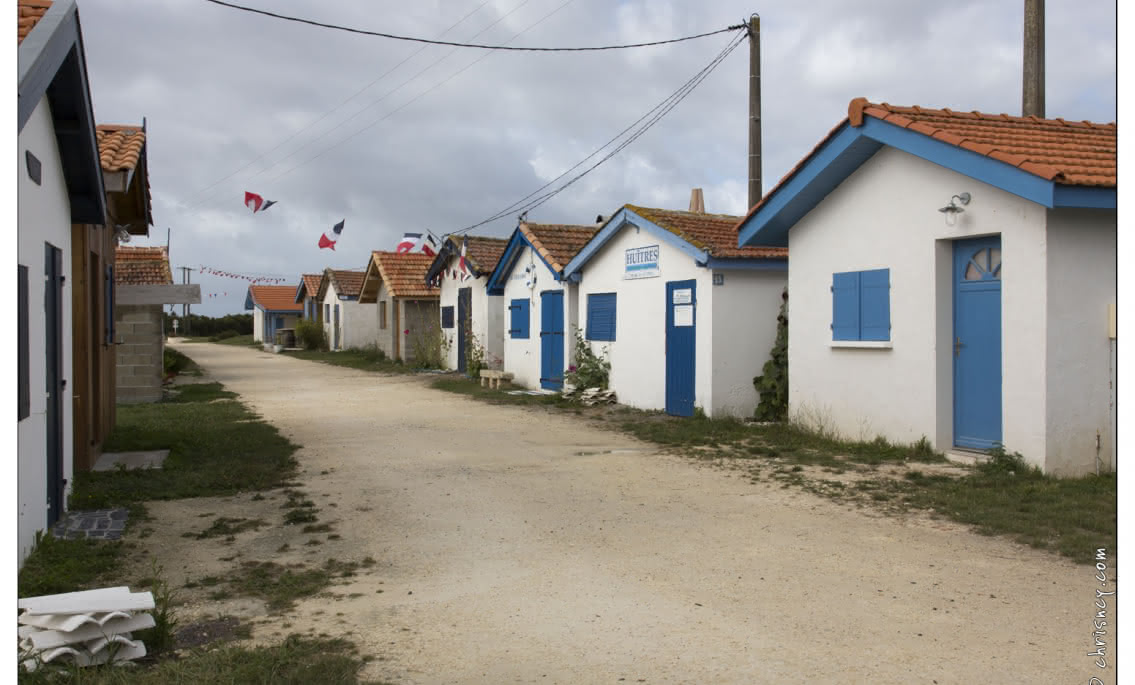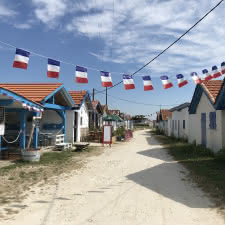Share your #edenaquitain find with your community!

Grand Tour de Talais
Homepage / Médoc Atlantique / At home – EN Activities Hiking and walks Walking itineraries Grand Tour de Talais
"A walking route rich in remarkable natural heritage, which gives the opportunity to discover the marsh and the oyster port of this small village of Talais. Starting from the village church, passing by the mattes, you will reach this old oyster port lined with atypical huts. For the most courageous, the walk extends to the estuary...
No difficulty, no change in altitude.
A family walk".
- an exceptional view of the Baluard marshes
- a lively and friendly port in season

Leave your car in the car park behind the church. At the corner of the large town house, take the route de Loumenade. 250m to the right in the meadow are the remains of a tumulus probably of Neolithic origin known as the "Motte du Castéra". Cross the crossroads, then turn left 200m along the gravel path to the Château. Walk 200m, then turn right along the passage de la pompe for 250m to the intersection. Turn left into the Chemin du Désert for 150m, then left into Rue Jean de l'Ouille for 150m. Turn right into rue de long Régat, then walk straight on for 925m and take the passe communale du Vigneau. Cross the junction with the D101 E3 (route de Grayan) and go straight ahead along the passe de la Cousteyre for 1,675 metres. Turn right along the D1E4, route de Saint Vivien, then walk for 300m. Cross the D1E4 and turn left along the passe communale for 850m, then left for 300m to the route des Cabireaux. Walk along the road for 625m and turn right onto the Prés du Moine pass for 550m. Continue along this pass, turning left for 1km as far as the passe Castillonnaise, the road from the port of Talais to Saint Vivien. Turn left for 450m and walk straight on to the port, skirting the mattes for around 2000m.
Plus de détails
Once you reach the port of Talais, cross it to the left and follow the cycle path for 800m towards the D1E4. In season, you can take a picnic break at the port (you can eat at the guinguette). The port is served by a cycle path leading to the Baluards oyster marsh and to the dyke along the estuary. Built by fishermen to exploit an ancient deposit of Portuguese oysters, this port once enjoyed a high level of activity, which declined and died out in the 1970s. The development of the banks of the estuary access channel and the renovation of the huts have enhanced this site, which is now open to visitors. When the weather is fine, you can enjoy a meal here, and why not try some of the oysters produced here.
Plus de détails
An observation point has been set up at the Baluard marsh. However, the footpath does not follow the track! Cross the D1E4 and continue along the cycle path for 1000m. Turn left onto the road for 100m as far as the junction. Cross the junction and take the road back to the centre of the village via the pump, as before, for 1000m as far as the car park.
Plus de détails
On your way back, you'll be surrounded by mattes. This cereal-growing land lies below the level of the highest tides. That's why maintaining the dykes is vital to their preservation. These lands, which emerged in the 17th century thanks to the techniques of Dutch engineers, are managed by a syndicate of owners, one of whose main tasks is to ensure that the hydraulic system functions properly. The syndicate's articles of association were registered by royal decree in the 19th century.
Plus de détailsThe man has always lived on the island that was once the village of Talais. Not far from the village centre, at the western entrance to the commune, you can see a series of earthen mounds. These mottes formed the foundations of a monument, perhaps of a votive and sacred nature, or perhaps a dwelling. The nearby presence of flint spearheads and bronze axes testifies to the human occupation of this site, dating back to the Neolithic period, when it was repopulated until more recent times. Currently in private ownership, the site is neither developed nor even signposted... It is interesting to look at the satellite views of this site, which show a vast field of traces of construction around the current remains.
Plus de détails
The man has always lived on the island that was once the village of Talais. Not far from the village centre, at the western entrance to the commune, you can see a series of earthen mounds. These mottes formed the foundations of a monument, perhaps of a votive and sacred nature, or perhaps a dwelling. The nearby presence of flint spearheads and bronze axes testifies to the human occupation of this site, dating back to the Neolithic period, when it was repopulated until more recent times. Currently in private ownership, the site is neither developed nor even signposted... It is interesting to look at the satellite views of this site, which show a vast field of traces of construction around the current remains.
Plus de détails
2014 saw the resumption of oyster farming along the estuary, which had previously been banned. The quality of the water now allows oysters to be matured in the marsh for sale to private individuals. The site also boasts a leisure area where the common denominator is a love of nature, including fishing and the observation of seabirds such as curlews, plovers, redshanks and various sandpipers.... There is also a picnic area where you can eat on site in a peaceful setting. A fishing net is available for visitors, mainly for mules and mullets, and can be hired from the Mairie.
Plus de détailsThis could interest you
There is nothing like a good walk to recharge your batteries! Come and enjoy the hiking trails, itineraries and marked trails. Breathe in the fresh air of the nature reserves, take the path to Soulac-sur-Mer or take a walk through the Médoc vineyards, just follow the guide!

